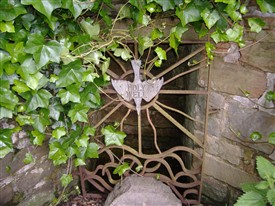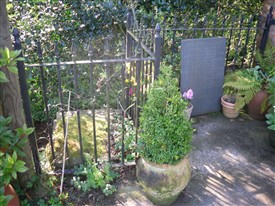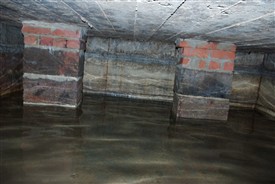The Holy Wells of Nottinghamshire

Watnall Holy well

St Catherine's Well, Southwell
RBParish

St John's Well, Welham the bath
RBParish
An overview of dedication, distribution, history and folklore
By R B Parish
What is a holy well?
What might appear to be a simple question is not easily answered. Hope (1893) is perhaps the first scholar to attempt a thorough account of the subject and includes a wide range of sites which include petrifying, haunted, ever-lasting, curative and those dedicated to saints such a clear and formal definition. The author for his series of works defines them as natural springs or even dug wells which have attracted religious, cult or ritual associations but for this article I have restricted the definition to those bearing a Christian dedications being called holy or named after a saint.
The range
The range of dedications is much more limited than surrounding counties, particularly Yorkshire, most being called simply Holy wells (10 confirmed sites, 20 possible sites), and those with names are restricted to presumably foreign or biblical saints: St. Mary (or rather Lady Wells) (9 with an extra 3 possible)*, St. Ann’s Well (2), St. Helen (1/2), St. Catherine’s (2) and St. John (2). With a possible St. Lawrence dedication, Jacob Well and Lord’s Well.
Recorded history
Unfortunately finding records of holy wells before the 18th century are rare. For example despite claims that Winkburn’s St. John’s Well was associated with the Order of St. John, there appears to be no contemporary reference. The earliest record in the county, although it is recorded as Cress Well, is Epperstone’s Lady Well when the site was given to the Priory of Thurgarton by a William Sampson in 1185. In Clumber park is recorded in 1232 Holywell Dale in Dukery Records. The Thurgarton Cartulary records a Halywillcliff in 1272-90 at Hickling and as noted by Foulds (1994). A number of quitclaims from Cossall record St. Helen’s Well. The earliest being 1280 when:
“William, son of Adam le Gaoler of Nottingham, and Beatrice and Agnes, heirs of Adam de Cossale concede, demise, confirm and release to William Snel de Barre and his wife Dionise...2 lie a square furlong of the spring of St. Elena between land of Stacy le Greyne and Nicholas de Marisco....”
A later report notes in 1301:
“two selions lying together at St. Helen’s Well, between the land of the Church of St. Katherine of Cossale on one side, and the land of the said Eustace on the other side, abutting at one end on the croft that Walter Talpe holds, and at the other end upon the north conduit”.
Lord Middleton’s Wollaton manuscripts suggest a Hallywell presumably at Wollaton recorded 1541 as when hay was collected and more interestingly on the 21st February 1575 when moles were killed when the person themselves ‘fyndinge hymselfe in Holywell and by the pools.’ Borrough Records record 1677 at Markham which may refer to either Headon’s Lady Well, an unknown site at Hawton or Newark’s St. Catherine’s Well. By the 1700s, sites such as Welham’s holy well are recorded and by the 1800s many sites are recorded in a vogue for spa springs such as Southwell’s St. Catherine’s Well which Dickinson (1819) notes that a Mr. Burton of Norwood Park built a house and bath at the site in 1720. He appears to have used the saint as support for its properties as:
“Over the head of the fountain was a plate, on which some Latin verses were inscribed, much to the honour of the tutelary saint, and the reputation of the water.”
Fabric
Presently many holy wells in the county consist of boggy overgrown morasses but this may not have been their condition at the height of their usage. Others have been rebuilt over the centuries whilst others such as the Holinwell retain a naturalistic nature. There does not appear to be a specific design for holy wells per se, but it appears a common structure was a brick or stone arch such as seen at Headon, Mansfield and Nottingham. This would appear to be the most substantial but easiest way to protect the waters. More function would be a bath structure suggested at Mansfield’s Lady Well, Southwell’s Lord’s and St Catherine’s Well but not fully described. St. Ann’s Well, Nottingham according to Thoroton (1797) flowed into a rectangular stone lined bath covered by an arched stone or brick roof, with some steps leading down into the water. The best known and only surviving bath, is that of St. John’s Well, Winkburn of which Mee (1938) describes as a stone basin twelve feet square with a flight of steps entering the water, although this dates from its development as a spa.
Traditions of Nottinghamshire holy wells
The county’s holy wells are not as endowed with traditions compared to neighbouring Derbyshire, Yorkshire or Lincolnshire. This may be due to the lack of any early records of their history. Except for St Ann’s Well, Nottingham and Newark’s St. Catherine’s well no wells have been recorded in detail pre Morrell’s 1988 attempt. This is unlike Lincolnshire whose sites are recorded by folklorists Gutch and Peacock (1908) and Rudkin (1936). The lack of a folklore volume in the Folklore society series may have resulted in a poor record of traditions and sites.
Many wells across the county have legends of their foundation, only one such site, St Catherine’s Well, Newark has such a tradition. Of this site Dickinson (1816) notes that a fair damsel of Newark, Isabel de Caldwell, had two lovers, Sir Everard Bevercotes and Sir Guy Saucimer. The rivals, fought over her hand and Sir Guy slew Sir Everard by the Devon bank, on St. Catharine's eve. Where the body of Sir Everard fell this spring gushed out, and has never since failed. Sir Guy fled to foreign lands and Isabel died of grief. Years later when he was stricken with leprosy, Sir Guy decided to return home and on his way St. Catherine appears to him in a vision, she tells him that where his crime was committed was a spring and this was only water that can cure his leprosy. Returning home he decided to build himself a hermitage on this spot and a chapel to St. Catharine. However, another version states that this site was regularly flooded by the nearby river Devon. This caused him to move site to another spring to the north-east and here he placed the chapel. Whichever is the exact story, he is said to ‘lived a sad and godly life’ to eighty-three, much venerated by all hereabouts, by whom he was known by the name of St. Guthred. Well dressing has been partly adopted by the county, but only the holy well to be so adorned was Headon’s Lady well, dressed from 1980 to the 1990s. Wakes and feast are often associated with holy wells and indeed at St John’s well Welham:
“Here was, until lately, a feast, or fair, held annually on St. John’s day, to which the neighbouring villagers resorted to enjoy such rural sports or games as fancy might dictate.”
The most famed of these observances is that of St. Ann’s Well,Nottingham. How much significance we should draw into the annual Easter Monday Mayoral ‘processions’ recorded in 17th century (it appears to have been more of a civic event with the tenant being obliged to provide food and drink for all that came) is unclear as was the role of the well itself. Was this the survival of an ancient custom? Morrell (1987b) notes that it was certainly not religious as it occurred after prayers and his opinion is that it was more of a social event. It is probable that the processions were more to do with land rights and hunting rights than the well. It may well have ceased at the Civil War. By the 18th century so-called Robin Hood relics were collected at the well and house. Hutton (1795) states that he was shown a slipper said to be the outlaws and Ritson (1884) notes:
“..went to visit the well and ancient chair of Robin Hood...Being placed in the chair, we had a cap, which they say was his, very formally put upon our heads, and having performed the usual ceremonies befitting so great a solemnity, we received the freedom of the city and were incorporated into the society of that renowned brotherhood.”
We of course should not read too much into this, being the type of money making scheme such as Greta green or Swearing the Horns at Highgate.
Newstead Abbey’s Mary’s Well or Monk’s Well was thought of as a wishing well and visited by pilgrims. The anonymous author of the 1950s guide states that one must drink the well and make a wish, but not tell anyone. They note that there was a recent case during the Great War, but gives no detail. The modern guide to the gardens notes that it was still used in the mid 20th century and its icy water was thought to have magical properties!
The most common tradition for sites is that they are healing properties. Of the site described however only 6 sites claim healing associations. Of these the commonest ailment cured was rheumatism. Such as Southwell’s Lord’s Well according to Shilton (1818), was also:
“effectual in the cure of rheumatism”
As was St. Catherine’s Well in the town, Tuxford’s Holy Well also for scurvy and St. John’s Well, Welham was said to be:
“good for rheumatics and scorbutic diseases”.
However, St. Ann’s Well, Nottingham was thought good for rheumatism and eye problems. An unsupported tradition is that it was visited by King Henry IV who suffered from leprosy. The oddest healing tradition is that recorded at Watnall’s little known Holy Well. The plaque there proclaims:
“HOLY WELL according to folklore in the c19 a small boy who lived opposite was so ill he was not expected to live. Here a priest baptised him and he recovered thereafter the well was considered holy.”
The late dedication of the site underlines the peculiar nature of the county’s holy well heritage. A heritage which with the exception of two sites, St Ann’s Well Nottingham and St. Catherine’s Well Newark, is fragmentary, a subject that appears to have escaped the attentions of antiquarians and historians and such although research indicates it follows trends elsewhere the lack of traditions suggests much has been lost and coverage is patchy.
Information taken from Holy wells and healing springs of Nottinghamshire. Available from Pixyledpublications rossparish@hotmail.com
* not including Orange’s (1840) Lady’s Bath as a possible origin of Lady Bay and a possible Lady Well at Egmanton, said by the Reverend Levy to have been associated with the vision of Our Lady to a local women at the edge of Ladywood. However, correspondence to long time residents in the parish has not revealed knowledge of the site nor has the Nottinghamshire record office. Interestingly, the suggested site does have oil wells which may suggest that the vision was due to a Willo the wisp!
References:
Anonymous, (1950) Newstead Abbey a concise handbook to the Abbey. Nottingham
Anonymous, (1957) Welham An ancient spa. Retford Times 14.6.57
Anonymous, (1970) Story of Clarborough. Retford Times 2.1.19.70
Anonymous, (undated) Newstead Abbey – A Tour of the Garden. Nottingham
Copnall, H. H., (1915) Nottinghamshire County Records – notes and extracts from the Nottinghamshire county records of the 17th century. Nottingham.
Dickinson, W., (1787) A History of the Antiquities of the Town and Church of Southwell, in the County of Nottingham. Nottingham.
Doubleday, W. E., (1946) Notts Villages: Felley, Nottinghamshire Guardian, 20 April
Foulds, T., (1994) The Thurgaton Cartulary Stamford.
Fyfe, W. F., (1856) Rambles round Nottingham. Nottingham
Groves, W. H., (1894) History of Mansfield. Nottingham
Gunn, J., (2003) A History of Epperstone. Nottingham
Harrod, W., (1801) A History of Mansfield and its environs. Nottingham
Mastoris S., (1998) Sherwood Forest in early 17th century.
Morrell, R. W., (1987b) St Ann's Well and Other Medicinal and Holy Wells of Nottingham. Nottingham
Morrell, R. W., (1988) Nottinghamshire Holy Wellsand Springs Nottingham
Parish, R.B., The Holy Wells and Healing Springs of Nottinghamshire (in search of holy wells volume III) Nottingham
Scales, W. J., (1896) St Catherine’s Well, Newark-on-Trent, Reliquary 2 pp 52–3.
Shilton, R. P., (1818) The History of Southwell in the county of Nottinghamshire. Nottingham
Stapleton, W., (1899) Some Account of the Religious Institutions of Old Nottingham. Nottingham
Stevenson, M. A., (1911) Report on the Manuscripts of Lord Middleton possessed at Wollaton Nottingham London.
Voigner-Marshall, J., (2003) Lord Byron’s Newstead Abbey. Australia.
Walker, V., and Duncan, G., (1940), Newstead Priory: Cartulary, 1344, and Other Archives. Nottingham.